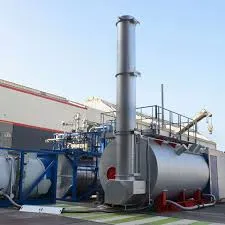
Feb . 08, 2025 00:42 Back to list
steam boiler corrosion
Exploring the realm of steam boiler corrosion introduces a complex yet fascinating narrative crucial for industries reliant on steam boilers for efficient operation. Reliable steam generation is the lifeblood of several sectors, from manufacturing to energy production. When corrosion rears its ugly head, operations can face costly downtimes and safety hazards, making it imperative for stakeholders to arm themselves with deep knowledge and effective solutions.
From a product perspective, the market offers a plethora of advanced treatments and coatings designed to mitigate corrosion. Innovations in boiler technology have resulted in the development of corrosion-resistant materials such as duplex stainless steels and proprietary alloy compositions. These materials exhibit high resistance to corrosive chemicals, providing an authoritative solution to those plagued by corrosion worries. Industry experts often recommend these advanced materials, particularly in high pressure and high temperature scenarios where traditional materials may falter. Furthermore, case studies in industries like paper production and oil refining have illustrated the benefits of investing in these innovative solutions. One notable case involved a major paper processing facility that drastically reduced unscheduled shutdowns by transitioning to a new boiler system constructed with high-grade stainless steel. Such transformations not only enhance operational reliability but also demonstrate the long-term cost-effectiveness that strategic material investments can offer. Trustworthiness in combating steam boiler corrosion is built on the foundations of transparency and empirical evidence. Providing customers with comprehensive data reflecting testing and adaptation to industry-specific conditions fosters confidence. Testimonials from trusted industry leaders and service providers corroborate the claims of effectiveness, ensuring that companies remain at the forefront of corrosion management solutions. In conclusion, addressing steam boiler corrosion is an intricate dance between scientific precision and strategic foresight. Experts in the field must leverage their knowledge, continually innovate, and maintain transparency to provide robust and trustworthy solutions. The adoption of sophisticated materials and processes not only preserves boiler longevity but also ensures uninterrupted industrial productivity, ultimately empowering businesses to steam ahead in a competitive landscape.


From a product perspective, the market offers a plethora of advanced treatments and coatings designed to mitigate corrosion. Innovations in boiler technology have resulted in the development of corrosion-resistant materials such as duplex stainless steels and proprietary alloy compositions. These materials exhibit high resistance to corrosive chemicals, providing an authoritative solution to those plagued by corrosion worries. Industry experts often recommend these advanced materials, particularly in high pressure and high temperature scenarios where traditional materials may falter. Furthermore, case studies in industries like paper production and oil refining have illustrated the benefits of investing in these innovative solutions. One notable case involved a major paper processing facility that drastically reduced unscheduled shutdowns by transitioning to a new boiler system constructed with high-grade stainless steel. Such transformations not only enhance operational reliability but also demonstrate the long-term cost-effectiveness that strategic material investments can offer. Trustworthiness in combating steam boiler corrosion is built on the foundations of transparency and empirical evidence. Providing customers with comprehensive data reflecting testing and adaptation to industry-specific conditions fosters confidence. Testimonials from trusted industry leaders and service providers corroborate the claims of effectiveness, ensuring that companies remain at the forefront of corrosion management solutions. In conclusion, addressing steam boiler corrosion is an intricate dance between scientific precision and strategic foresight. Experts in the field must leverage their knowledge, continually innovate, and maintain transparency to provide robust and trustworthy solutions. The adoption of sophisticated materials and processes not only preserves boiler longevity but also ensures uninterrupted industrial productivity, ultimately empowering businesses to steam ahead in a competitive landscape.
Share
Prev:
Latest News
-
High-Efficiency Commercial Oil Fired Steam Boiler for Industry
NewsJul.30,2025
-
High-Efficiency Biomass Fired Thermal Oil Boiler Solutions
NewsJul.30,2025
-
High Efficiency Gas Fired Thermal Oil Boiler for Industrial Heating
NewsJul.29,2025
-
High-Efficiency Gas Fired Hot Water Boiler for Sale – Reliable & Affordable
NewsJul.29,2025
-
High Efficiency Biomass Fired Hot Water Boiler for Industrial and Commercial Use
NewsJul.29,2025
-
High-Efficiency Biomass Fired Hot Water Boiler for Industrial Use
NewsJul.28,2025
Related PRODUCTS
Copyright © 2025 HEBEI HONGZE BOILER MANUFACTURING CO., LTD. All Rights Reserved. Sitemap | Privacy Policy






















